Visualization of Coastal Carbonate Lithosomes: Color-Intensity Patterns and Georadar Imaging of a Semi-Lithified Strandplain, Eleuthera Island, The Bahamas
Abstract
1. Introduction
2. Study Site
3. Materials and Methods
4. Results
5. Discussion
6. Conclusions
Author Contributions
Funding
Data Availability Statement
Acknowledgments
Conflicts of Interest
References
- Tamura, T. Beach ridges and prograded beach deposits as palaeoenvironment records. Earth-Sci. Rev. 2012, 114, 279–297. [Google Scholar] [CrossRef]
- Isla, M.F.; Moyano-Paz, D.; FitzGerald, D.M.; Simontacchi, L.; Veiga, G.D. Contrasting beach-ridge systems in different types of coastal settings. Earth Surf. Process. Landf. 2023, 48, 47–71. [Google Scholar] [CrossRef]
- Kindler, P. Coastal response to the Holocene transgression in the Bahamas: Episodic sedimentation versus continuous sea-level rise. Sediment. Geol. 1992, 80, 319–329. [Google Scholar] [CrossRef]
- Neumann, A.C.; Hearty, P.J. Rapid sea-level changes at the close of the last interglacial (substage 5e) recorded in Bahamian island geology. Geology 1996, 24, 775–778. [Google Scholar] [CrossRef]
- Khan, N.S.; Ashe, E.; Horton, B.P.; Dutton, A.; Kopp, R.E.; Brocard, G.; Engelhart, S.E.; Hill, D.F.; Peltier, W.; Vane, C.H.; et al. Drivers of Holocene sea-level change in the Caribbean. Quat. Sci. Rev. 2017, 155, 13–36. [Google Scholar] [CrossRef]
- Savarese, M.; Curran, H.A. Origin of Late Holocene strandplains in the southern Exuma Islands, Bahamas: Progradation, ephemeral highstands, and storminess. In Proceedings of the 16″ Symposium on the Geology of the Bahamas and Other Carbonate Regions; Glumac, B., Savarese, M., Eds.; Gerace Research Centre: San Salvador, Bahamas, 2016; pp. 39–59. [Google Scholar]
- Cescon, A.L.; Cooper, J.A.G.; Jackson, D.W.T. Nature distribution of beach ridges on the islands of the Greater Caribbean. J. Mar. Sci. Eng. 2024, 12, 565. [Google Scholar] [CrossRef]
- Buynevich, I.V.; Savarese, M.; Curran, H.A.; Bitinas, A.; Glumac, B.; Pupienis, D.; Kopcznski, K.A.; Dobrotin, N.; Gnivecki, P.L.; Park Boush, L.E.; et al. Sand incursion into temperate (Lithuania) and tropical (the Bahamas) maritime vegetation: Georadar visualization of target-rich aeolian lithosomes. Estuar. Coast. Shelf Sci. 2017, 195, 69–75. [Google Scholar] [CrossRef]
- Shinn, E.A. Burrowing in Recent Lime Sediments of Florida and the Bahamas. J. Paleontol. 1968, 42, 879–894. [Google Scholar]
- Porter, S.C. High resolution paleoclimatic information from Chinese eolian sediments based on grayscale intensity profiles. Quat. Res. 2000, 53, 70–77. [Google Scholar] [CrossRef]
- Buynevich, I.V.; Davydov, O.V.; FitzGerald, D.M. Coastal inlet analysis by image color intensity variations: Implications for the barrier coast of Ukraine. J. Mar. Sci. Eng. 2025, 13, 72. [Google Scholar] [CrossRef]
- Davis, J.L.; Annan, A.P. Ground-penetrating radar for high-resolution mapping of soil and rock stratigraphy. Geophys. Prospect. 1989, 37, 531–551. [Google Scholar] [CrossRef]
- Baker, P.L. Response of ground-penetrating radar to bounding surfaces and lithofacies variations in sand barrier sequences. Explor. Geophys. 1991, 22, 19–22. [Google Scholar]
- Jol, H.M.; Bristow, C.S. GPR in sediments: Advice on data collection basic processing interpretation a good practice guide. In Ground Penetrating Radar in Sediments; Bristow, C.S., Jol, H.M., Eds.; Geological Society of London, Special Pub: London, UK, 2003; Volume 11, pp. 9–27. [Google Scholar]
- Dougherty, A.J. Prograded coastal barriers provide paleoenvironmental records of storms and sea level during late Quaternary highstands. J. Quat. Sci. 2018, 33, 501–517. [Google Scholar] [CrossRef]
- Hesp, P.A. Foredunes and blowouts: Initiation, geomorphology and dynamics. Geomorphology 2002, 48, 245–268. [Google Scholar] [CrossRef]
- Pedersen, K.; Clemmensen, L.B. Unveiling past aeolian landscapes; a ground-penetrating radar survey of a Holocene coastal dunefield system, Thy, Denmark. Sediment. Geol. 2005, 177, 57–86. [Google Scholar] [CrossRef]
- Buynevich, I.V.; Savarese, M.; Kadurin, S.V.; Larchenkov, E.P.; Park Boush, L.E.; Curran, A.H.; Beal, I.A. Morphodynamics and geological legacy of berm scarps along non-tidal (Ukraine) and microtidal (the Bahamas) coasts. Geol. Geogr. Bull. Odesa Natl. Univ. Ukr. 2014, 19, 177–187. [Google Scholar]
- Tõnisson, H.; Suursaar, U.; Kont, A.; Muru, M.; Rivis, R.; Rosentau, A.; Tamura, T.; Vilumaa, K. Rhythmic patterns of coastal formations as signs of past climate fluctuations on uplifting coasts of Estonia, the Baltic Sea. J. Coast. Res. Spec. Issue 2018, 85, 611–615. [Google Scholar] [CrossRef]
- Tamura, T.; Cunningham, A.C.; Oliver, T.S.N. Two-dimensional chronostratigraphic modelling of OSL ages from recent beach-ridge deposits, SE Australia. Quat. Geochronol. 2019, 49, 39–44. [Google Scholar] [CrossRef]
- Suursaar, U.; Rosentau, A.; Hang, T.; Tõnisson, H.; Tamura, T.; Vaasma, T.; Vandel, E.; Vilumaa, K.; Sugita, S. Climatically induced cyclicity recorded in the morphology of uplifting Tihu coastal ridgeplain, Hiiumaa Island, eastern Baltic Sea. Geomorphology 2022, 404, 108187. [Google Scholar] [CrossRef]
- Goslin, J.; Clemmensen, L.B. Proxy records of Holocene storm events in coastal barrier systems: Storm-wave induced markers. Quat. Sci. Rev. 2017, 174, 80–119. [Google Scholar] [CrossRef]
- FitzGerald, D.M.; Fenster, M.S.; Argow, B.; Buynevich, I.V. Coastal impacts due to sea-level rise. Annu. Rev. Earth Planet. Sci. 2008, 36, 601–647. [Google Scholar] [CrossRef]
- Botha, G.A.; Bristow, C.S.; Porat, N.; Duller, G.; Armitage, S.J.; Roberts, H.M.; Clarke, B.M.; Kota, M.W.; Schoeman, P. Evidence for dune reactivation from GPR profiles on the Maputuland coastal plain South Africa. In Ground Penetrating Radar in Sediments; Bristow, C.S., Jol, H.M., Eds.; Geological Society of London, Special Publication: London, UK, 2003; Volume 211, p. 2946. [Google Scholar]
- Bristow, C.S. Ground Penetrating Radar in Aeolian Dune Sands In Ground Penetrating Radar: Theory and Applications; Jol, H.M., Ed.; Elsevier: Amsterdam, The Netherlands, 2009; pp. 273–297. [Google Scholar]
- Jol, H.M.; Smith, D.G.; Meyers, R.A. Digital ground penetrating radar (GPR): An improved and very effective geophysical tool for studying modern coastal barriers (examples for the Atlantic, Gulf and Pacific coasts, USA). J. Coast. Res. 1996, 12, 960–968. [Google Scholar]
- Schenk, C.J.; Gautier, D.L.; Olhoeft, G.R.; Lucius, J.E. Internal structure of an eolian dune using ground-penetrating radar. In Eolian Sediments: Ancient and Modern, International Association of Sedimentologists; Pye, K., Lancaster, N., Eds.; Special Publication: London, UK, 1993; Volume 16, pp. 61–69. [Google Scholar]
- Neal, A.; Roberts, C.L. Applications of ground-penetrating radar (GPR) to sedimentological and geomorphological archaeological studies in coastal environments. In Coastal and Estuarine Environments: Sedimentology, Geomorphology and Geoarchaeology; Pye, K., Allen, J.R.L., Eds.; Geological Society of London, Special Publication: London, UK, 2000; Volume 175, pp. 139–171. [Google Scholar]
- Grasmueck, M.; Weger, R. 3D GPR reveals complex internal structure of Pleistocene oolitic sandbar. Lead. Edge 2002, 21, 634–639. [Google Scholar] [CrossRef]
- van Dam, R.L.; Nichol, S.L.; Augustinus, P.C.; Parnell, K.E.; Hosking, P.L.; McLean, R.F. GPR stratigraphy of a large active dune on Parengarenga Sandspit, New Zealand. Lead. Edge 2003, 22, 865–870. [Google Scholar] [CrossRef]
- Havholm, K.G.; Ames, D.V.; Whittecar, G.R.; Wenell, B.A.; Riggs, S.R.; Jol, H.M.; Berger, G.W.; Holmes, M.A. Stratigraphy of back-barrier coastal dunes northern North Carolina southern Virginia. J. Coast. Res. 2004, 20, 980–999. [Google Scholar] [CrossRef]
- Harris, J.G.; Mylroie, J.E.; Carew, J.L. Banana holes: Unique karst features of the Bahamas. Carbonates Evaporites 1995, 10, 215–224. [Google Scholar] [CrossRef]
- Mylroie, J.E. Late Quaternary sea-level position: Evidence from Bahamian carbonate deposition and dissolution cycles. Quat. Int. 2008, 183, 61–75. [Google Scholar] [CrossRef]
- Lundberg, J.; Taggart, B.E. Dissolution pipes in northern Puerto Rico: An exhumed paleokarst. Carbonates Evaporites 1995, 10, 171–183. [Google Scholar] [CrossRef]
- Stott, P. Ground-penetrating radar: A technique for investigating the burrow structure of fossorial vertebrates. Wildl. Res. 1996, 22, 519–530. [Google Scholar] [CrossRef]
- Sherrod, L.W.; Sauck, E.; Simpson, D.D., Jr.; Werkema, J. Swiontek. Case histories of GPR for animal burrow mapping and geometry. J. Environ. Eng. Geophys. 2019, 24, 1–17. [Google Scholar] [CrossRef]
- Kinlaw, A.E. M Grasmueck. Evidence for and geomorphologic consequences of a reptilian ecosystem engineer: The burrowing cascade initiated by the gopher tortoise. Geomorphology 2012, 157, 108–121. [Google Scholar] [CrossRef]
- Chlaib, H.K.; Mahdi, H.; Al-Shukri, H.; Su, M.M.; Catakli, A.; Abd, N. Using ground penetrating radar in levee assessment to detect small-scale animal burrows. J. Appl. Geophys. 2014, 103, 121–131. [Google Scholar] [CrossRef]
- Hearty, P.J.; Olson, S.L. Preservation of trace fossils and molds of terrestrial biota by intense storms in mid–last interglacial (MIS 5c) dunes on Bermuda, with a model for development of hydrological conduits. Palaios 2011, 26, 394–405. [Google Scholar] [CrossRef]
- Hearty, P.J.; Olson, S.L.; Kaufman, D.S.; Edwards, R.L.; Cheng, H. Stratigraphy and geochronology of pitfall accumulations in caves and fissures, Bermuda. Quat. Sci. Rev. 2004, 23, 1151–1171. [Google Scholar] [CrossRef]
- Martin, A.J. Trace Fossils of San Salvador; Gerace Research Centre: San Salvador, Bahamas, 2006; 80p. [Google Scholar]
- Bishop, G.A.; Pirkle, F.L.; Meyer, B.K.; Pirkle, W.A.; The Foundation for Sea Turtle Geoarchaeology and Zooarchaeology: Morphology of Recent and Ancient Sea Turtle Nests, St. Catherines Island, Georgia, and Cretaceous Fox Hills Sandstone, Elbert County, Colorado. 2011. Available online: https://www.researchgate.net/publication/286002271_The_foundation_for_sea_turtle_geoarchaeology_and_zooarchaeology_Morphology_of_recent_and_ancient_sea_turtle_nests_St_Catherines_Island_Georgia_and_cretaceous_fox_hills_sandstone_Elbert_county_Colorado (accessed on 1 April 2025).
- Buynevich, I.V.; Savarese, M.; Curran, H.A.; Gnivecki, P.L.; Berman, M.J. Coastal morphological and geoarchaeological implications of prehistoric sea turtle nesting in the Bahamian Archipelago. In Joint Symposium on the Natural History and Geology of the Bahamas, 1st ed.; Gerace Research Centre: San Salvador, Bahamas, 2015; pp. 8–9. [Google Scholar]
- Boyajian, G.E.; Thayer, C.W. Clam calamity; a recent supratidal storm-deposit as an analog for fossil shell beds. Palaios 1995, 10, 484–489. [Google Scholar] [CrossRef]
- Roberts, E.M.; Tapanila, L.; Mijal, B. Taphonomy sedimentology of storm-generated continental shell beds: Acase example from the Cretaceous Western Interior Basin. J. Geol. 2008, 116, 462–479. [Google Scholar] [CrossRef]
- Buynevich, I.V.; Savarese, M.; Curran, H.A.; Ingalsbe, T.A. Storm-generated molluscan thanatocoenosis along a carbonate paleoshoreline: Southern Eleuthera Island, The Bahamas. Current Challenges of Science and Education. In Proceedings of the 10th International Scientific and Practical Conference, Berlin, Germany, 3–25 June 2024; pp. 243–248. [Google Scholar]
- Stone, J.W.; Orford, J.D. Storms and their significance in coastal morpho-sedimentary dynamics. Mar. Geology 2004, 210, 1–5. [Google Scholar] [CrossRef]
- Mann, M.E.; Woodruff, J.D.; Donnelly, J.P.; Zhang, Z. Atlantic hurricanes and climate over the past 1500 years. Nature 2009, 460, 880–885. [Google Scholar] [CrossRef] [PubMed]
- Nott, J. A theory (involving tropical cyclones) on the formation of coarse-grained sand beach ridges in NE Australia. Geol. Soc. Lond. Spec. Publ. 2010, 346, 7–22. [Google Scholar] [CrossRef]
- Park, L.E. Comparing two long-term hurricane frequency intensity records from San Salvador Island Bahamas. J. Coast. Res. 2012, 28, 891–902. [Google Scholar]
- Wallace, E.J.; Donnelly, J.P.; van Hengstum, P.J.; Wiman, C.R.; Sullivan, M.; Winkler, T.S.; d’Entremont, N.E.; Toomey, M.; Albury, N. Intense hurricane activity over the past 1500 years at south Andros Island, the Bahamas. Paleoceanogr. Paleoclimatol. 2019, 34, 1761–1783. [Google Scholar] [CrossRef]
- Schmitt, D.; Gischler, E.; Melles, M.; Wennrich, V.; Behling, H.; Shumilovskikh, L.; Anselmetti, F.S.; Vogel, H.; Peckmann, J.; Birgel, D. An annually resolved 5700-year storm archive reveals drivers of Caribbean cyclone frequency. Sci. Adv. 2025, 11, eads5624. [Google Scholar] [CrossRef] [PubMed]
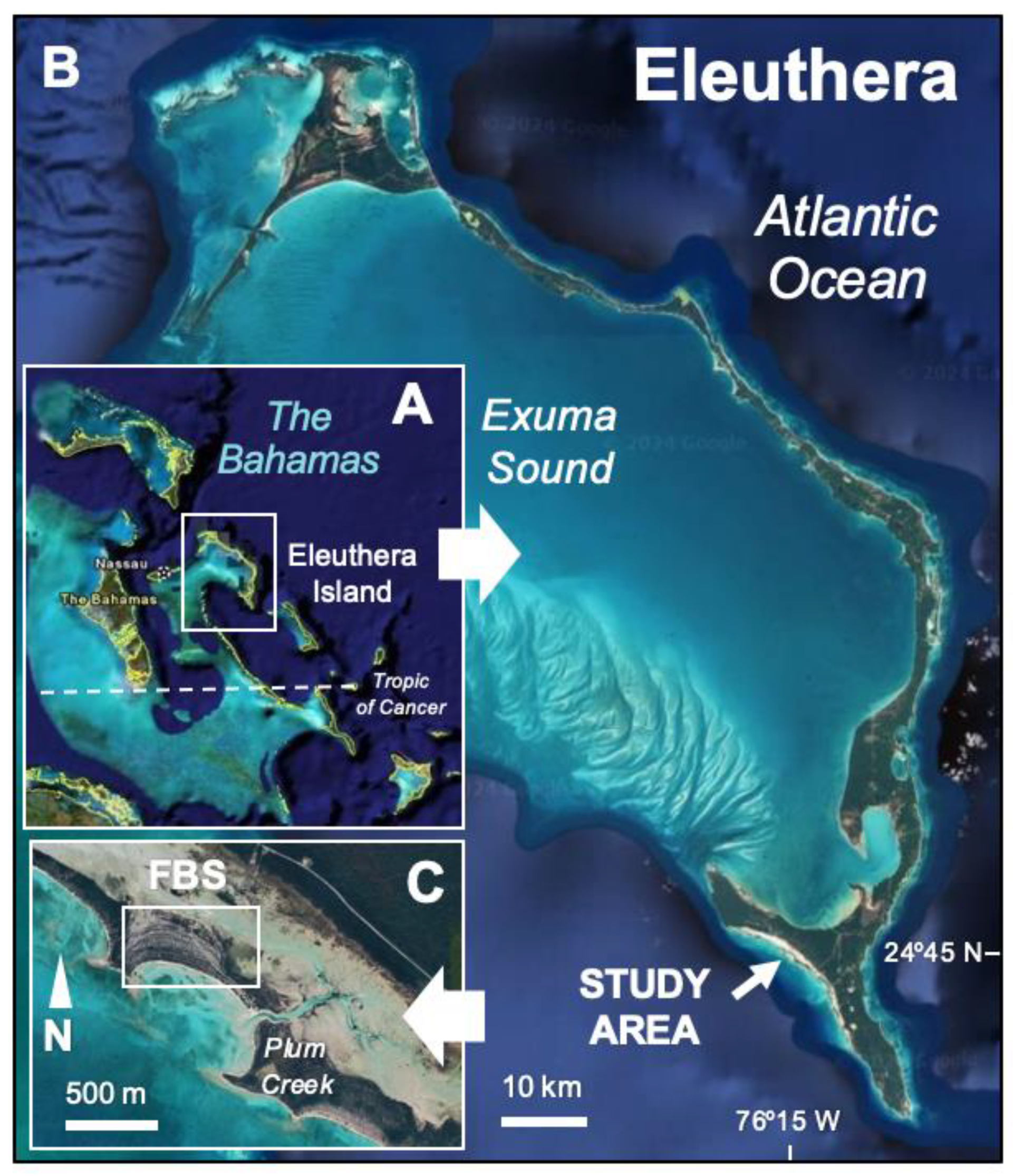
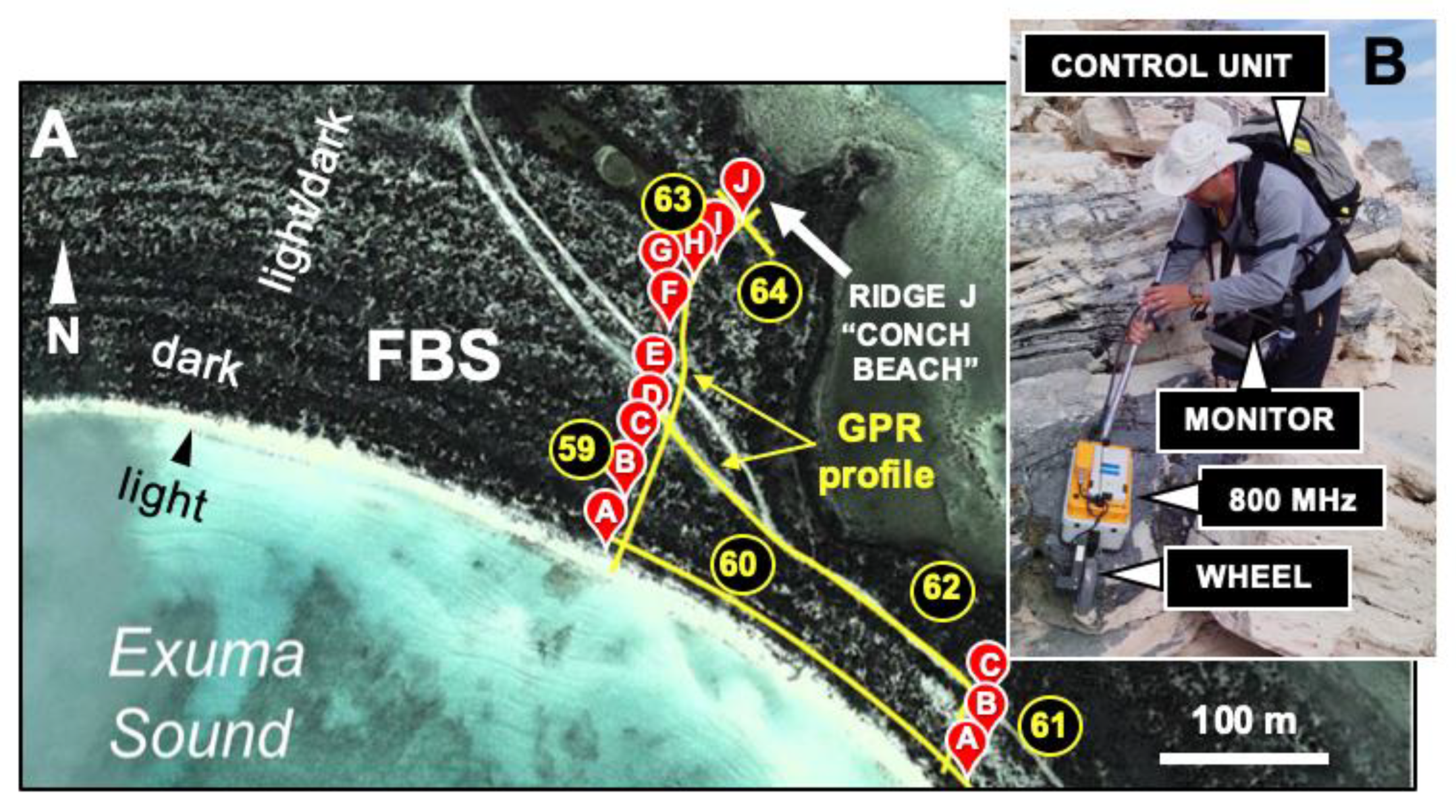

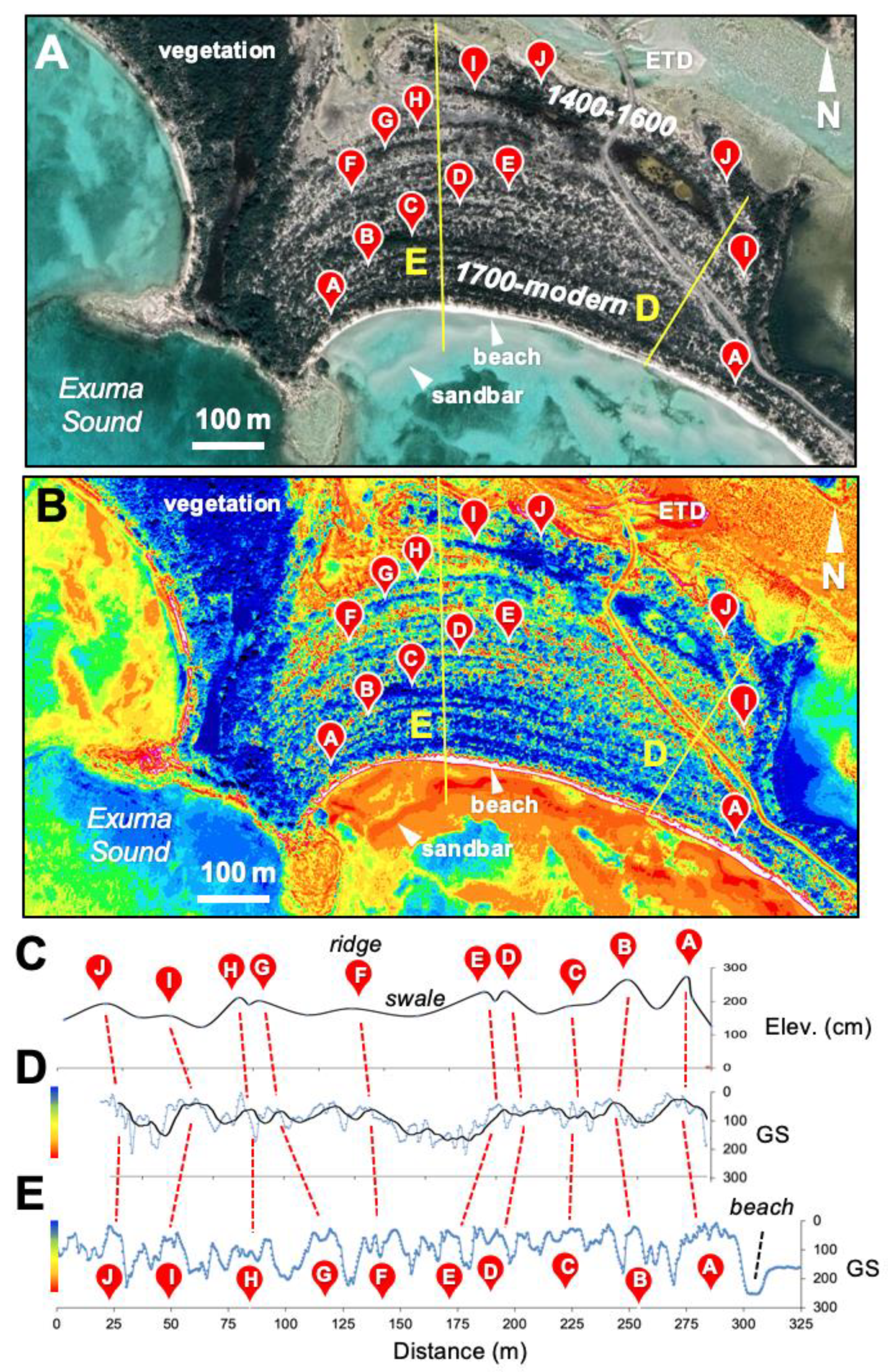
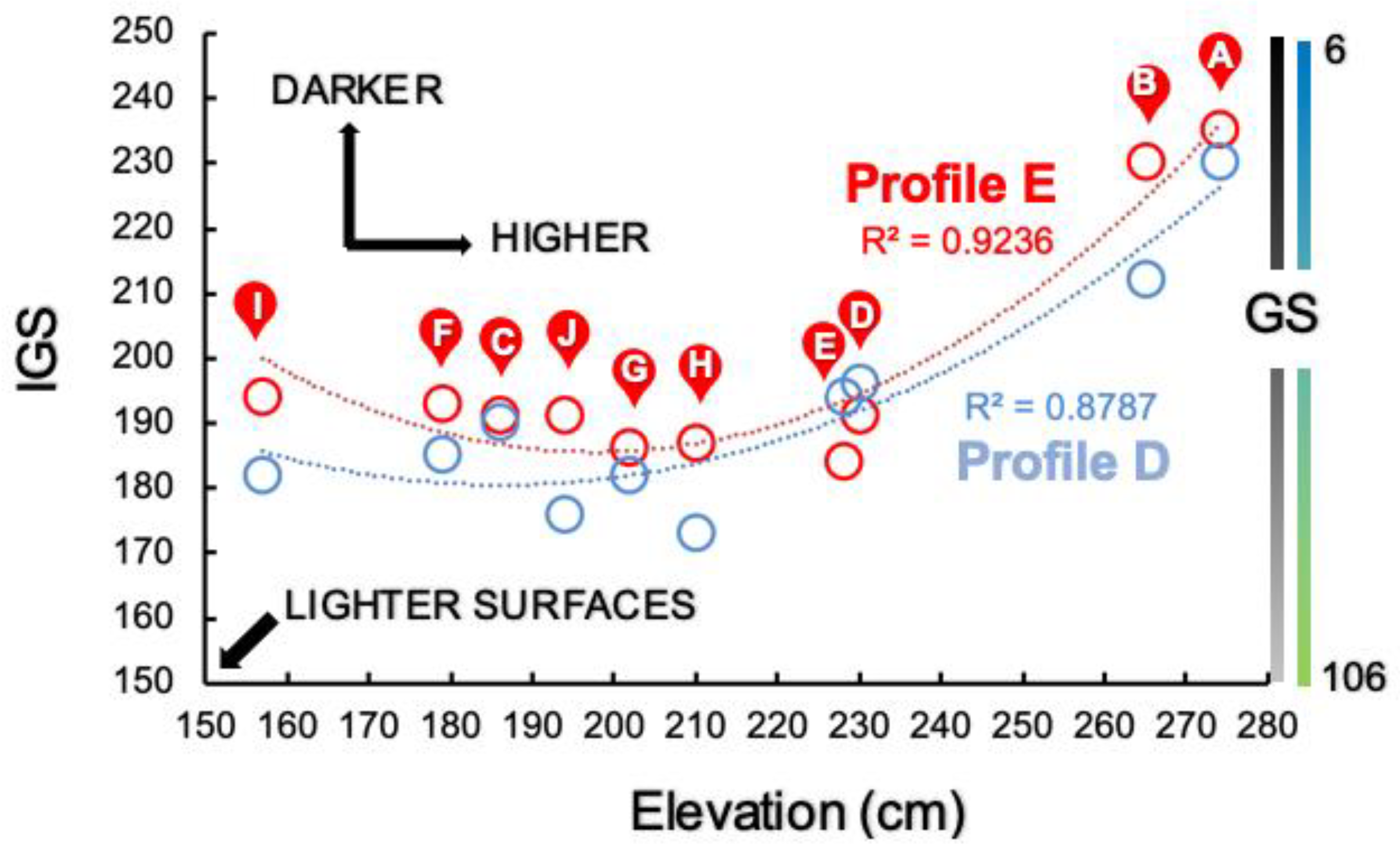
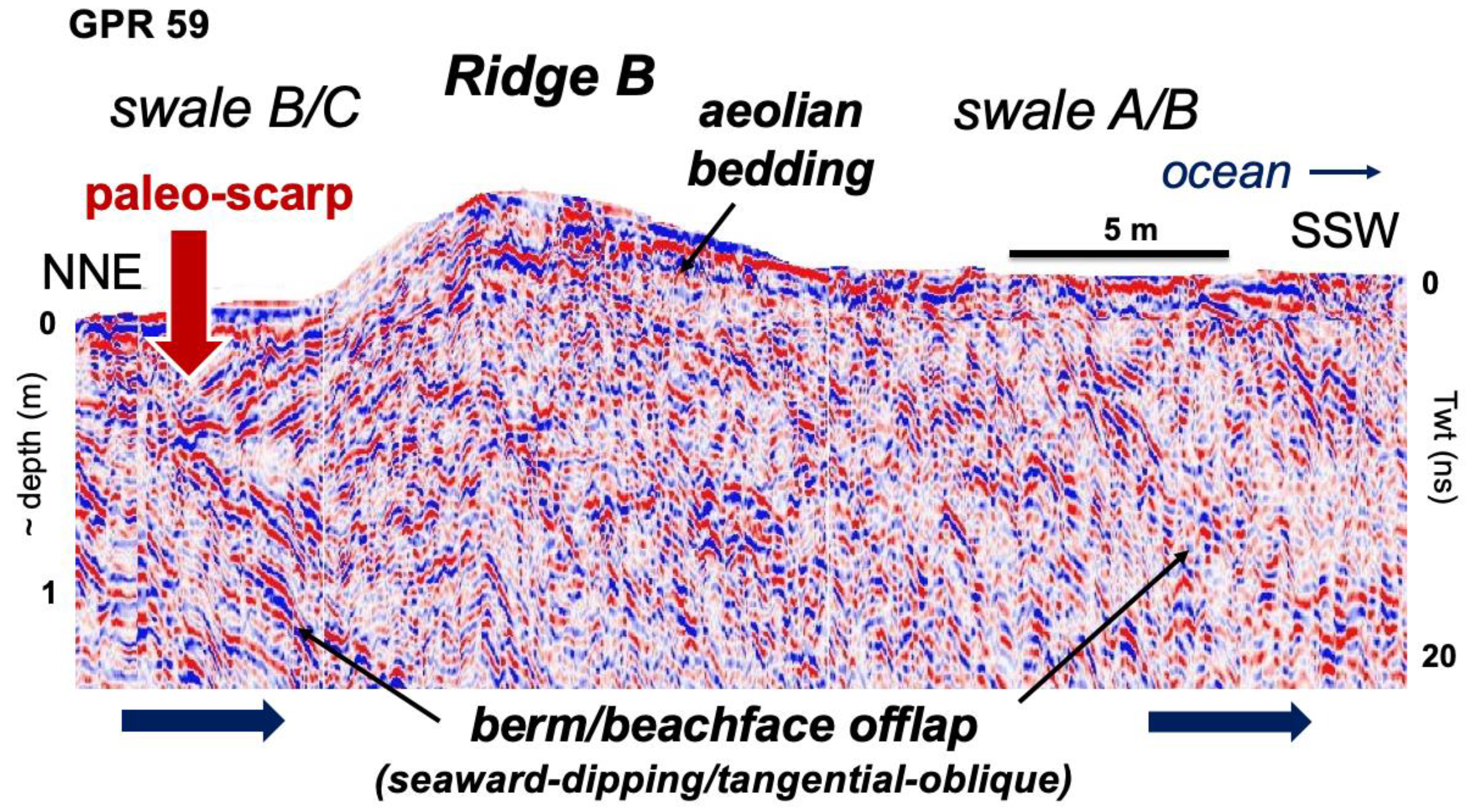


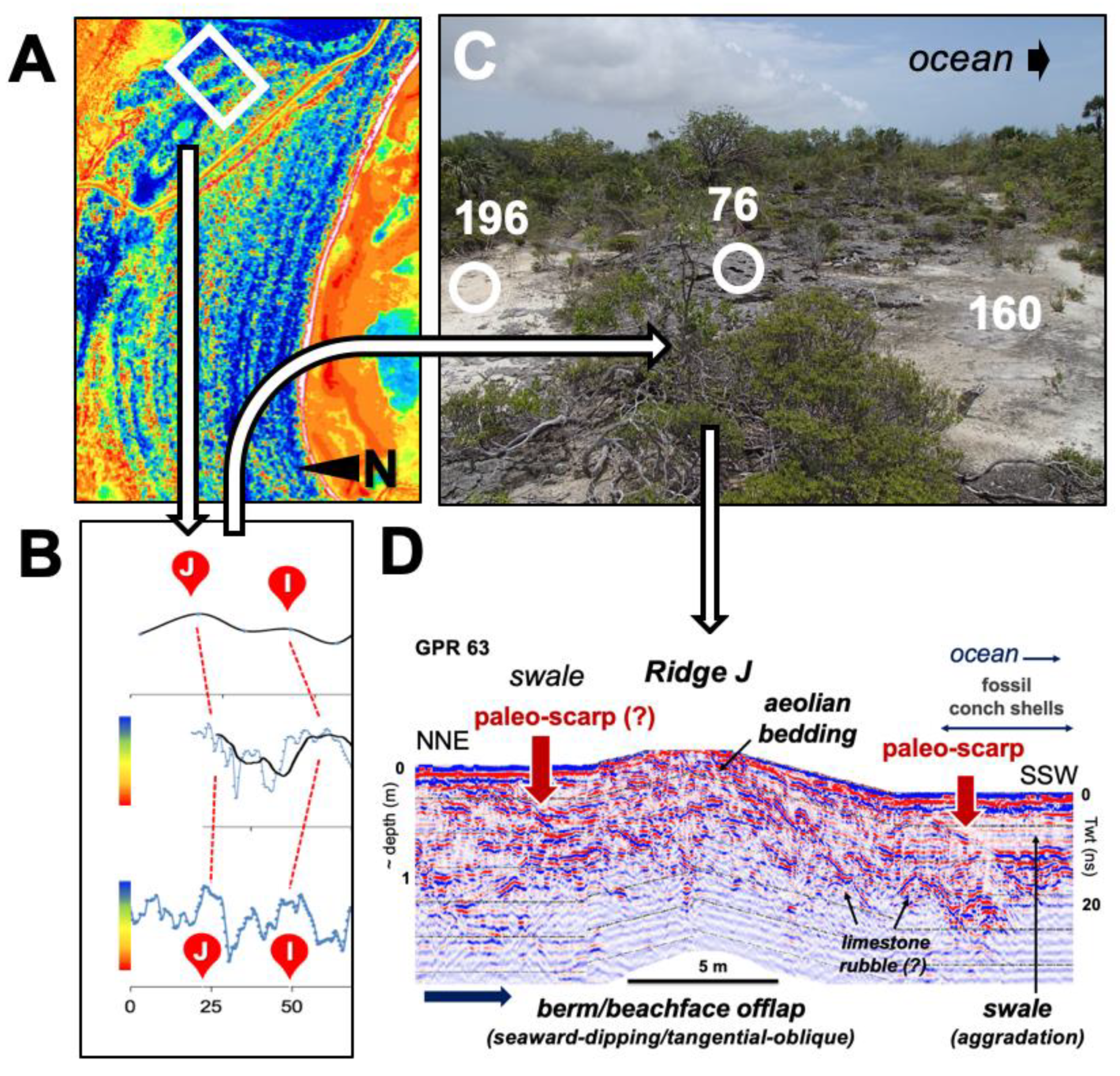
Disclaimer/Publisher’s Note: The statements, opinions and data contained in all publications are solely those of the individual author(s) and contributor(s) and not of MDPI and/or the editor(s). MDPI and/or the editor(s) disclaim responsibility for any injury to people or property resulting from any ideas, methods, instructions or products referred to in the content. |
© 2025 by the authors. Licensee MDPI, Basel, Switzerland. This article is an open access article distributed under the terms and conditions of the Creative Commons Attribution (CC BY) license (https://creativecommons.org/licenses/by/4.0/).
Share and Cite
Buynevich, I.V.; Savarese, M.; Curran, H.A. Visualization of Coastal Carbonate Lithosomes: Color-Intensity Patterns and Georadar Imaging of a Semi-Lithified Strandplain, Eleuthera Island, The Bahamas. J. Mar. Sci. Eng. 2025, 13, 950. https://doi.org/10.3390/jmse13050950
Buynevich IV, Savarese M, Curran HA. Visualization of Coastal Carbonate Lithosomes: Color-Intensity Patterns and Georadar Imaging of a Semi-Lithified Strandplain, Eleuthera Island, The Bahamas. Journal of Marine Science and Engineering. 2025; 13(5):950. https://doi.org/10.3390/jmse13050950
Chicago/Turabian StyleBuynevich, Ilya V., Michael Savarese, and H. Allen Curran. 2025. "Visualization of Coastal Carbonate Lithosomes: Color-Intensity Patterns and Georadar Imaging of a Semi-Lithified Strandplain, Eleuthera Island, The Bahamas" Journal of Marine Science and Engineering 13, no. 5: 950. https://doi.org/10.3390/jmse13050950
APA StyleBuynevich, I. V., Savarese, M., & Curran, H. A. (2025). Visualization of Coastal Carbonate Lithosomes: Color-Intensity Patterns and Georadar Imaging of a Semi-Lithified Strandplain, Eleuthera Island, The Bahamas. Journal of Marine Science and Engineering, 13(5), 950. https://doi.org/10.3390/jmse13050950






